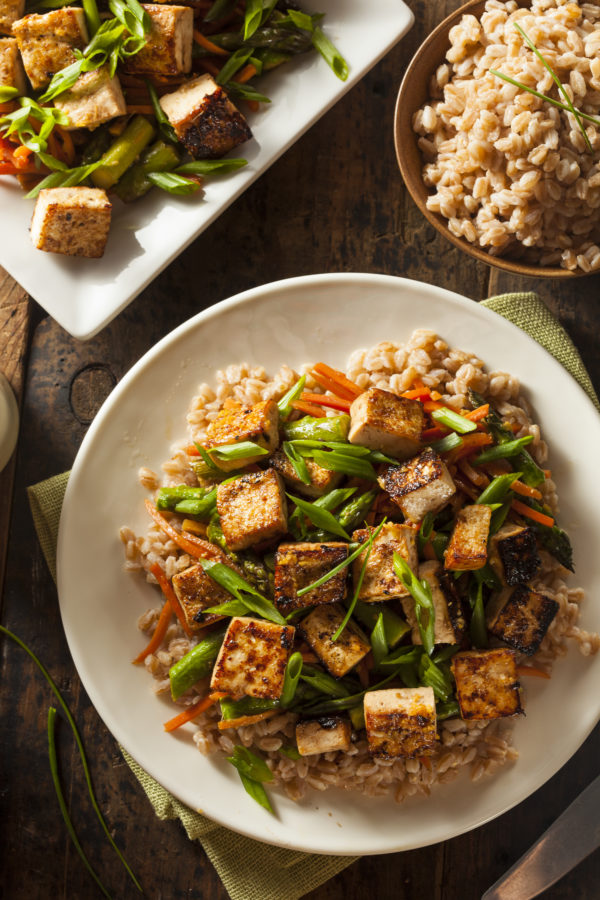
We asked a nutritionist to rank the 7 most popular meat substitutes
There are a lot of benefits to following a plant-based diet: It’s environmentally friendly, and it’s generally better for your health. But if you love burgers, bacon, and steak, the meat substitutes for vegans and vegetarians have historically been pretty sad.
Thankfully, as more and more people adopt plant-based eating at least some of the time, the alt-meat options have gotten way better—providing the texture and flavor you’re looking for without using any animal products whatsoever. That way, you can still satisfy that “meaty” craving without succumbing to a lonely life of lettuce and veggie bowls.
Not sure which meat substitutes are the healthiest, or how to cook with them? Here’s what an RD has to say.
Also Read: Plant-Based Diets Good for the Planet, and for You
Best for beginners: Tofu
Of all the alt-meats, you’re probably most familiar with tofu. Tofu is made from condensed soy milk that’s filtered and processed to make white blocks of varying firmness. “While it is high in protein and contains all of the essential amino acids the body needs for protein synthesis, it is also a good source of magnesium, calcium, selenium and phosphorus,” says Maggie Michalczyk, MS, RD. It has a neutral flavor that takes on whatever you’re cooking with, which makes it super versatile.
Some people are skittish about soy because of concerns that their natural phytoestrogens could negatively affect people’s hormones. But most research has debunked this. “Some studies have shown that eating soy products 1-2 a week can reduce the risk of breast cancer,” Michalczyk adds. Generally, most experts will say that soy is safe in moderate amounts for most healthy adults, but people who are pregnant or who have hormone-related cancers should talk to their doctors before adding it in earnest to their diets.
Still, you’ll want to find organic products (since soy is a common GMO crop), she says. Beyond that, anyone can eat it as long as they don’t have a soy allergy.
Best if you’re avoiding soy: Seitan
Protein:22 grams per 100-gram serving
Seitan is made from wheat protein (a.k.a. gluten) and it’s super high in protein. It’s not a complete protein though—it lacks the amino acids lysine and threonine. You’ll want to pair it with something else to fulfill your essential amino acid requirements, like quinoa, pumpkin seeds, white beans, cheese, or lentils.
“It can be eaten the same way you would eat chicken—sliced onto a salad, with a side of veggies,” Michalczyk says. It is very dense and thick in texture (it resembles meat the most) so it works well as a sandwich alt-meat, a taco filling, or strips on a bed of lettuce. You can also find several options that are pre-flavored or packaged with a barbecue or teriyaki sauce.
This is one of the few meat substitutes for vegans and vegetarians that isn’t made with soy—making it a good option for people who have soy allergies or who are trying to avoid it. However, if you have Celiac disease or a non-Celiac gluten sensitivity, steer clear of seitan.
Best for the gut: Tempeh
Protein:20 grams per 100-gram serving
Like tofu, tempeh is a soy-based meat alternative that’s also high in protein. “It’s made from soy beans that are soaked and softened. Then it’s cooked, slightly fermented and formed into a firm patty or block,” says Michalczyk. Tempeh may also be made from other bean varieties, wheat, or a mixture of soybeans and wheat, she explains.
In addition to being rich in protein, tempeh is high in iron, calcium, magnesium, phosphorus, and manganese, so it’s a nutritional powerhouse. “This extra nutrient boost makes it a strong nutrition choice,” she says.
It’s also good for your gut, and not just because it’s fermented. “It contains prebiotics, which is fiber that promotes the growth of beneficial bacteria in your digestive system,” she adds. It’s also pretty low in sodium for better heart health and to reduce bloating.
It can be used the same way you would eat meat—as a topper for salads, in a stir-fry, or by itself as being either baked or steamed. It’s sold in “cakes,” and it tastes sweet and nutty, and a bit earthy, so you can eat it raw without cooking it if you like. It has a slightly stronger taste than tofu or other more neutral meat alternatives, so it might not be good for someone new to plant-based eating.
Check labels—if it is made from a wheat mixture, people who cannot eat gluten should avoid it. It’s also not a fit for those with a soy allergy. “It is great for people who are dairy free or lactose intolerant because it’s a good source of calcium,” she says.
Best If you’re avoiding processed food: Jackfruit
Protein: 3 grams per serving
Jackfruit is a South Asian fruit that when underripe, has a neutral flavor and a texture similar to pulled pork. “It can be consumed in both sweet and savory dishes,” says Michalczyk In the last few years it’s grown in popularity as a meat substitute because of it’s texture and protein content (3 grams per serving) which is higher than most fruits,” she says. You can eat it plain or cooked, and it can take on whatever you’re cooking it with, too.
Compared to other alt-meats, it’s drastically lower in protein—so you shouldn’t depend on it as the sole source of protein in your life. However, you may want to add other sources of protein when eating, like beans, legumes, or protein-dense veggies. Plus, some of the pre-seasoned, pre-packaged varieties are high in sugar. Still, Michalczyk likes this option because it isn’t overly processed like many other meat substitutes.
Best for die-hard meat lovers: Beyond Meat / Impossible Burger
Protein: 20 grams per serving (Beyond); 19 grams per serving (Impossible)
These buzzy alt-meats are the modern upgrade to veggie burgers that taste (and in the case of Impossible, “bleed”) and look like ground beef. Beyond Meat uses pea protein isolate as its primary source of protein, and Impossible Burger recently reformulated to use soy and potato proteins.
However, while both products are made with plant-based ingredients, they’re pretty processed and raise some red flags nutritionally, Joan Soalge Blake, RD, previously told Well+Good. “A lot of these plant-based burgers are getting a lot of press, but I would prefer for people to find an alternative with less saturated fat,” she said. The Beyond Burger has five grams of saturated fat (25 percent of your recommended daily limit) per serving, while the Impossible Burger has eight grams per serving—a whopping 40 percent of your daily limit. (The saturated fat count in both comes from coconut oil.) This isn’t a huge deal every once in a while—just don’t make the juicy meatless burger an everyday thing.
Best for an occasional short cut: Soy Dogs
Protein: Varies
Soy dogs are just like hot dogs, but they’re meat-free and made from soy or wheat protein instead. While these products often have fewer calories and saturated fat compared to their meat counterparts, they’re not Michalczyk’s favorite meatless option.
“I wouldn’t make these a diet staple if you are vegan or vegetarian but I think they are okay to eat once in a while,” she says. They’re generally highly processed and contain additional ingredients like corn syrup and high amounts of sodium. Some soy dogs are also made with egg white protein, so check the label carefully if you’re vegan. “For people who are generally just adding more plant-based protein to their diet, I think there are plenty other ways to get it besides soy dogs,” she says. But they’re fine as an occasional part of your diet (say at a friend’s summer barbecue).
Best if you’re bored with your other options: Textured Vegetable Protein
Protein: 12 grams per 1/4-cup serving
Textured vegetable protein (also known as textured soy protein or soy meat) is a crumbly soy product made from soy flour. It resembles ground beef, which makes it a popular meat substitute. However, it’s another very processed product, Michalczyk says.
It is a complete source of protein, and she likes that it has a bit of fiber and is low in sodium. “TVP also contains magnesium—a mineral most people don’t get enough of—phosphorus, iron and calcium,” she says. “Some TVP can contain other processed ingredients depending on how it’s made, so again it’s very important to read ingredient labels and choose one that contains only soy.”
If you’re allergic to soy, don’t eat it, but if you’re looking for something new, then sure. Still, Michalczyk doesn’t think this is a great option compared to the others higher up on this list.

